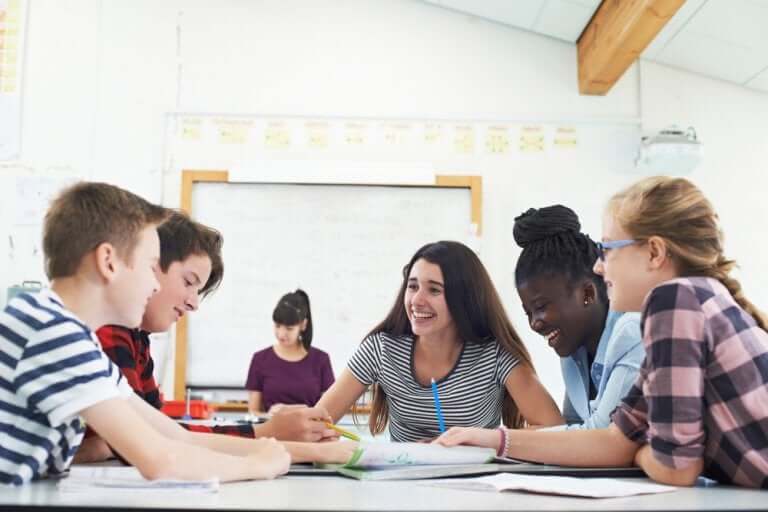5 Tips to Create Effective Class Work Groups

With the creation of effective class work groups – groups of students who learn to work together well – both teachers and students can benefit greatly. Making these student groups is relatively easy, but making them effective is a little more complicated.
It’s common for students to create their own work groups, and this has advantages and disadvantages. If learners create their own work groups, then they’ll take into account things like their emotions, closeness and friendship with their peers, rather than each member’s skills or competencies.
The positive side here is that the group would probably work very well together. However, the negative side is that it won’t be a group where everyone will be able to give their best.
So, let’s look at some ideas about what we can do to make group work in the classroom more efficient by creating effective groups of learners.
5 tips for creating effective class work groups
Number of participants
When deciding on how many members each group should have, the total number of students in the classroom must be taken into account. If it’s a large class, then we can make several groups. Ideally, though, we should never create working groups with more than 5 members.

Larger groups wouldn’t be conducive to good concentration when carrying out the work. It would also be more difficult to separate the tasks, or assign each member something specific, taking into account their skills and interests.
It’s the teacher’s job to decide the exact number of members in each group and to make sure that the number established at its time of creation is respected.
Cognitive dissonance can be positive
A group is a potential source of cognitive dissonance and yet it may also be the best place to minimize it. Disagreement with other group members creates dissonance; trying to reach agreements reduces this tension.
A really positive factor in these cases is for a teacher to encourage their students to overcome this cognitive dissonance. They should try to make them see that it’s common for these things to happen. If disagreements arise between members, then it’s something they can draw many positive experiences from.
The Zone of Proximal Development to create efficient groups of learners
Using the Zone of Proximal Development (ZDP) is also a good tool to consider when creating effective groups of students in the classroom. This is how Vygotsky defines this ZDP:
“The distance between the actual level of development that is determined by independent problem solving and the level of potential development that is determined by problem solving under the guidance of adults or in collaboration with other more capable ones.”
– Vygotsky –
It’s a zone for building. In a group, everyone has something they already know and something they are about to know; between peers they’re going to support each other and help each other to build up their knowledge.
Rules in the group
The teacher must set the rules that the group must follow in advance. This includes deadlines for submitting the work, its format, and the type of presentation the group must make. They must also unify the group and clarify what the working methods should be. These methods should enable everyone to contribute something and delegate and share out the work fairly.

Diversity and versatility
There should be a good variety in the group members. You should take into account personalities, abilities, what each one will bring to the group, and how they can benefit from being a part of it. The teacher must participate in the creation of the groups in some way, either through a game or simply by giving recommendations to the students.
Compatibility (and incompatibilities) between members should be taken into account, and equal participation between male and female students should be considered. It’s also important to ask each student about their preferences and to try to take them into account, as far as possible. In a group there should always be students who are able to help others and students who need to be helped.
Once we manage to create effective class work groups that work well, then we can take them into account for future activities and work in other subjects, and with other objectives which differ from the initial objective the group was created for. It’s also a good idea to create other different groups for specific tasks. It’s sensible to combine members, in order to try to get all the students to interact with each other.
With the creation of effective class work groups – groups of students who learn to work together well – both teachers and students can benefit greatly. Making these student groups is relatively easy, but making them effective is a little more complicated.
It’s common for students to create their own work groups, and this has advantages and disadvantages. If learners create their own work groups, then they’ll take into account things like their emotions, closeness and friendship with their peers, rather than each member’s skills or competencies.
The positive side here is that the group would probably work very well together. However, the negative side is that it won’t be a group where everyone will be able to give their best.
So, let’s look at some ideas about what we can do to make group work in the classroom more efficient by creating effective groups of learners.
5 tips for creating effective class work groups
Number of participants
When deciding on how many members each group should have, the total number of students in the classroom must be taken into account. If it’s a large class, then we can make several groups. Ideally, though, we should never create working groups with more than 5 members.

Larger groups wouldn’t be conducive to good concentration when carrying out the work. It would also be more difficult to separate the tasks, or assign each member something specific, taking into account their skills and interests.
It’s the teacher’s job to decide the exact number of members in each group and to make sure that the number established at its time of creation is respected.
Cognitive dissonance can be positive
A group is a potential source of cognitive dissonance and yet it may also be the best place to minimize it. Disagreement with other group members creates dissonance; trying to reach agreements reduces this tension.
A really positive factor in these cases is for a teacher to encourage their students to overcome this cognitive dissonance. They should try to make them see that it’s common for these things to happen. If disagreements arise between members, then it’s something they can draw many positive experiences from.
The Zone of Proximal Development to create efficient groups of learners
Using the Zone of Proximal Development (ZDP) is also a good tool to consider when creating effective groups of students in the classroom. This is how Vygotsky defines this ZDP:
“The distance between the actual level of development that is determined by independent problem solving and the level of potential development that is determined by problem solving under the guidance of adults or in collaboration with other more capable ones.”
– Vygotsky –
It’s a zone for building. In a group, everyone has something they already know and something they are about to know; between peers they’re going to support each other and help each other to build up their knowledge.
Rules in the group
The teacher must set the rules that the group must follow in advance. This includes deadlines for submitting the work, its format, and the type of presentation the group must make. They must also unify the group and clarify what the working methods should be. These methods should enable everyone to contribute something and delegate and share out the work fairly.

Diversity and versatility
There should be a good variety in the group members. You should take into account personalities, abilities, what each one will bring to the group, and how they can benefit from being a part of it. The teacher must participate in the creation of the groups in some way, either through a game or simply by giving recommendations to the students.
Compatibility (and incompatibilities) between members should be taken into account, and equal participation between male and female students should be considered. It’s also important to ask each student about their preferences and to try to take them into account, as far as possible. In a group there should always be students who are able to help others and students who need to be helped.
Once we manage to create effective class work groups that work well, then we can take them into account for future activities and work in other subjects, and with other objectives which differ from the initial objective the group was created for. It’s also a good idea to create other different groups for specific tasks. It’s sensible to combine members, in order to try to get all the students to interact with each other.
All cited sources were thoroughly reviewed by our team to ensure their quality, reliability, currency, and validity. The bibliography of this article was considered reliable and of academic or scientific accuracy.
- Chaiklin, Seth. The zone of proximal development in Vygotsky’s analysis of learning and instruction. Vygotsky’s educational theory in cultural context. 2003.
- Castañeda, Elsa. Investigación iberoamericana sobre eficacia escolar. Convenio Andrés Bello. 2007.
This text is provided for informational purposes only and does not replace consultation with a professional. If in doubt, consult your specialist.








